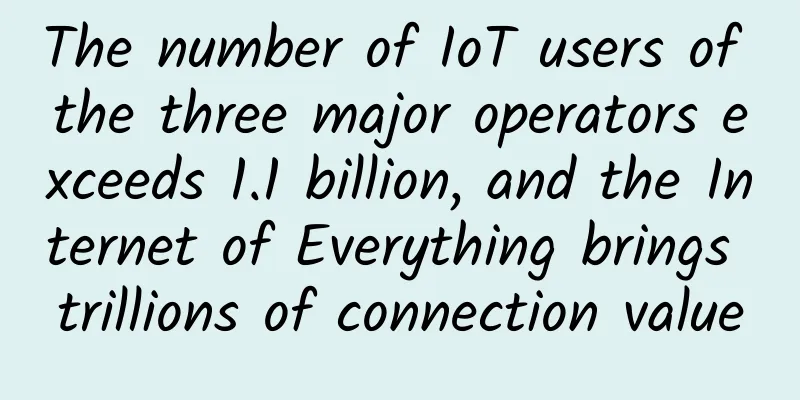The number of IoT users of the three major operators exceeds 1.1 billion, and the Internet of Everything brings trillions of connection value

|
5G opens a new era of the Internet of Everything. The industry generally expects that the IoT market will be a trillion-dollar market, and the number of IoT connections will be in the billions. Driven by both technology and the market, the three major operators are accelerating their embrace of the IoT, and the door to new opportunities is opening.
IoT users are catching up with mobile phone usersThe scale of cellular IoT users of the three major operators continues to expand rapidly. According to data disclosed by the Ministry of Industry and Information Technology, as of the end of February, the three operators had developed 1.154 billion cellular IoT terminal users, of which terminal users used in smart manufacturing, smart transportation, and smart public utilities accounted for 17.7%, 20.9%, and 21.8% respectively. The number of smart transportation terminal users (including Internet of Vehicles terminals) increased by 29.6% year-on-year, with the most prominent growth. The picture shows the situation of IoT terminal users at the end of February 2020-2021. Source: Ministry of Industry and Information Technology report In recent years, the cellular Internet of Things of the three major operators has been developing rapidly. Data shows that in 2018, the three major operators developed 671 million cellular Internet of Things users, with a net increase of 400 million households throughout the year. In 2019, the number of cellular Internet of Things users reached 1.03 billion, with a net increase of 357 million households throughout the year. In 2020, the number of Internet of Things users exceeded 1.1 billion, and in the first two months of 2021, there was a net increase of 18.27 million households compared with the end of the previous year. Data released by the three major operators in February showed that the mobile phone users of China Mobile, China Telecom and China Unicom were 937.169 million, 352.8 million and 306 million respectively, totaling 1,596.41 million. The 1.154 billion IoT users have exceeded 70% of mobile phone users in the Chinese market. By comparison, it can be seen that with the disappearance of the demographic dividend, the number of mobile phone users has reached its ceiling and the possibility of continued high-speed growth is not great. According to the current development momentum, it is not long before the number of IoT users of the three major operators exceeds that of mobile phone users, and IoT users will also become a new growth pole for operators' users. Operators' IoT applications are flourishingOperators have been deploying in the field of Internet of Things for many years. Data shows that China Telecom currently has more than 200 million Internet of Things users and nearly 80 million NB-IoT users. The number of NB-IoT connections ranks first in the world, and the NB market share ranks first in the industry. The number of NB-IoT smart water and smart gas connections exceeds 20 million, and is applied to multiple fields such as smart meter reading, smart parking, smart street lights, smart home appliances, public utilities, Internet of Vehicles, retail services, smart homes, industrial Internet of Things, smart logistics and other industries.
In terms of social governance, China Telecom's Tianyi Smart Community series of applications based on the Internet of Things technology has spread across 31 provinces, autonomous regions and municipalities across the country, and the total number of Tianyi Smart Community services has exceeded 16,000. Tianyi loudspeakers based on the Internet of Things technology, with the powerful function of "one-click shouting", have deeply served rural areas, parks, campuses, communities and other areas, allowing the scientific epidemic prevention voice to reach thousands of households. In the field of smart cities, Tianyi IoT has built a smart city perception platform by providing solutions for communities, pan-parks, urban security, transportation and other fields. It has built the country's first city-level IOT platform in Xiongan, which can provide stable street light IoT services through NB-IoT technology, realize intelligent dimming, power reduction, on-demand switching of lights and other management, and save energy by 30%-60%. In the field of Internet of Vehicles, China Telecom Tianyi IoT has provided intelligent Internet of Vehicles services to Shanghai GM, Xpeng Motors, Yuchai Machinery, Great Wall Motors, Evergrande Auto and other automakers. In terms of platform services, China Telecom has deployed the world's first remote multi-active NB-IoT device service platform in the field of the Internet of Things, which can provide services for more than 100 million IoT devices and ensure the security of end-to-end business processes. China Telecom has also continuously strengthened its ubiquitous intelligent connection capabilities, upgraded its IoT open platform (CTWing), and provided services such as 5G IoT private network, First IoT private line, unified service gateway, and NB-IoT gateway to help traditional industries transform and upgrade digitally. China Telecom will build hundreds of solutions for 12 sub-industries based on the IoT open platform, and develop in coordination with smart communities and smart homes.
China Mobile and China Unicom are also not willing to lag behind. China Mobile is actively forging integrated 5G+ IoT capabilities of "cloud, network, edge, and end", and continuously iterating the IoT core capability platforms OneLink and OneNET. It has opened more than 1,100 APIs in total, with an average of more than 1 billion API calls per day. China Mobile's IoT smart hardware covers many industries in China, including smart homes, smart meter reading, smart parking, smart wearables, and Internet of Vehicles. China Unicom focuses on key industry fields, starting from "cloud, network, terminal, edge and industry", and strives to build connection management, equipment management and industry terminal capabilities to enable industry transformation. Among them, in terms of connection management, China Unicom Internet of Things has the world's largest single connection management platform, carrying 228 million connections. According to data from market research firm IoT Analytics, China's three major operators - China Telecom, China Unicom and China Mobile - have become leaders in the global cellular IoT market in terms of cellular IoT connections. Together, the three operators account for 75% of global cellular IoT connections. In the 5G era, operators have great potential in tapping into the Internet of Things5G and the Internet of Things are important development directions for the communications industry in the next 10 years. With the advancement of 5G commercialization, the scale of the Internet of Things industry, as the most important application scenario of 5G, has ushered in rapid development. According to data from the Ministry of Industry and Information Technology, the overall scale of China's Internet of Things is expected to exceed 2 trillion in 2020. The China Academy of Information and Communications Technology predicts that the number of 5G connections in my country will increase rapidly over time and will reach 428 million by 2025.
In recent years, the Internet of Things has become a new business growth point for operators. Data from the Ministry of Industry and Information Technology show that the three operators' revenue from emerging businesses such as big data, cloud computing, artificial intelligence, and the Internet of Things has grown rapidly. In January and February, the three operators achieved a total revenue of 36.2 billion yuan in related businesses, a year-on-year increase of 28.9%, which has effectively promoted the growth of telecommunications business revenue. Currently, the three major operators are stepping up the construction of 5G networks. China has now achieved full coverage at the municipal level and major hotspots in more than 300 cities, and is promoting the extension of 5G to some counties and township hotspots. 5G networks have the characteristics of high capacity and low latency. The gradually improving coverage of 5G networks is laying the foundation for the Internet of Things. At the same time, operators are accelerating the expansion of IoT vertical industry applications and service areas. China Unicom has currently joined hands with more than 300 national lighthouse customers to jointly develop a new 5G industry ecosystem and create the IoT autonomous terminal brand logo Yanfei. Currently, the four Yanfei series industrial gateways have achieved mainstream protocol coverage and support more than 95 types of industrial protocols. The industry has reached a consensus on the opportunities of operators in the Internet of Things, from connections to solutions. China Telecom's Internet of Things open platform provides flexible and convenient device access services such as terminal SDKs, edge gateways, and object models to meet the access needs of massive IoT terminals. At the same time, the platform is also compatible with multiple standards and protocols, and provides a rich northbound API to maximize rapid empowerment, helping customers reduce costs, increase efficiency, and achieve value growth. |
<<: Growth and development opportunities brought by 5G to IoT companies
>>: Facebook and Google plan to lay submarine cables from the United States to Southeast Asia
Recommend
Jack Ma summoned by Indian court! Alibaba's Wang Shuai: I couldn't find him after searching for a whole day
On July 26, foreign media reported that a court i...
AkkoCloud: UK CN2 GIA/Germany CN2 GIA/US CN2 GIA annual payment starts from 299 yuan
At present, it is still a good choice to visit ov...
A revolutionary product that inspires the times! Huawei Mate X, a foldable phone, brings a whole new user experience
2019 has come to an end, and the annual flagships...
iWebFusion dedicated server starts from $49/month, 4-40 core CPU, 384G memory, NVMe hard disk, 1-10G bandwidth, multiple computer rooms in Los Angeles and other places
iWebFusion (formerly iWFHosting) is a hosting com...
The seven-layer network model and TCP, UDP, what happens in an HTTP request
[[267883]] 1. Seven-layer network model The http ...
HostYun Hong Kong Tsuen Wan AMD series VPS simple test
The day before yesterday, we shared the informati...
Huawei Cloud WeLink is officially released, an intelligent work platform that understands enterprises better
[Beijing, China, December 26, 2019] Today, Huawei...
User says | IPL helps medical experimental training to get on the fast track
Anhui Medical College is a public general college...
Which 5G operator has the fastest internet speed in Hong Kong? Speedtest announces the results
Last year, Hong Kong officially launched 5G netwo...
How wireless mesh networking technology can power smart buildings
Smart buildings are becoming increasingly importa...
iOVZ VPS in March 20% off monthly payment and 30% off annual payment, South Korea/Los Angeles data center available
iOVZ Cloud has launched a regular promotion in Ma...
Megalayer: Hybrid cloud servers/high-defense servers up to 60% off, Hong Kong dedicated servers from 399 yuan/month, VPS up to 50% off
Megalayer released a promotional plan for March, ...
Yunfan Accelerator CTO Fu Kai: Stick to the origin and become a technical CDN company
On April 12-13, 2017, the 2017 Asia Pacific CDN S...
Broadband as a Service: The End of DDoS?
【51CTO.com Quick Translation】With the continuous ...
How IPv6 works in the Internet
[[342618]] This article is reprinted from the WeC...









